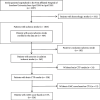NT-proBNP Levels and Collateral Circulation Status in Patients with Acute Ischemic Stroke
- PMID: 37091896
- PMCID: PMC10121344
- DOI: 10.1155/2023/5318012
NT-proBNP Levels and Collateral Circulation Status in Patients with Acute Ischemic Stroke
Abstract
Methods: In this study, 326 hospitalized patients with acute anterior circulation ischemic stroke (AACIS) were included. A comparison of the clinical characteristics of those with and without AF was conducted. The Spearman rank correlation was used for the correlation analysis of plasma NT-proBNP level, regional leptomeningeal collateral (rLMC) score, and computed tomography perfusion (CTP) status in the AF and non-AF groups. An analysis of multivariate linear regression was used to determine how plasma NT-proBNP level, rLMC score, and CTP status influenced the score on the NIHSS.
Results: There was a greater plasma NT-proBNP level in the AF group compared with the non-AF group, an increased CTP volume (including CTP ischemic volume, CTP infarct core volume, and CTP ischemic penumbra volume (P = 0.002)), higher NIHSS score on admission, and lower rLMC score (P < 0.001 for the remaining parameters). A negative correlation exists between plasma NT-proBNP level and rLMC score (r = -0.156, P = 0.022), but a positive correlation exists between plasma NT-proBNP level and both CTP ischemic volume and CTP infarct core volume (r = 0.148, P = 0.003) in the AF group, but not in the non-AF group. Multivariate linear regression analysis demonstrated that NT-proBNP, CTP ischemic penumbra volume, and rLMC score were associated with NIHSS score, and NT-proBNP was positively associated with NIHSS scores (95% confidence interval (CI), 0.000-0.002; P = 0.004) in the AF group, whatever in the unadjusted model or adjusted models, but not in the nonlarge artery atherosclerosis (LAA) group.
Conclusion: In AACIS patients with AF, NT-proBNP level negatively correlated with collateral status, positively with CTP ischemic volume, and positively with NIHSS score.
Copyright © 2023 Xiaozhu Shen et al.
Conflict of interest statement
The authors declare that they have no conflict of interest.
Figures



Similar articles
-
Elevated NT-proBNP levels are associated with CTP ischemic volume and 90-day functional outcomes in acute ischemic stroke: a retrospective cohort study.BMC Cardiovasc Disord. 2022 Sep 30;22(1):431. doi: 10.1186/s12872-022-02861-w. BMC Cardiovasc Disord. 2022. PMID: 36180827 Free PMC article.
-
Topographic correlation of infarct area on CT perfusion with functional outcome in acute ischemic stroke.J Neurosurg. 2020 Jan 1;132(1):33-41. doi: 10.3171/2018.8.JNS181095. Epub 2019 Jan 11. J Neurosurg. 2020. PMID: 30641833
-
Assessment of Relationship between Serum NT-proBNP Levels with Clinical Features and Prognosis in Acute Ischemic Stroke Patients.Neurol India. 2022 Nov-Dec;70(6):2401-2406. doi: 10.4103/0028-3886.364072. Neurol India. 2022. PMID: 36537423
-
Clinical and Imaging Parameters Associated With Hyperacute Infarction Growth in Large Vessel Occlusion Stroke.Stroke. 2019 Oct;50(10):2799-2804. doi: 10.1161/STROKEAHA.119.025809. Epub 2019 Aug 20. Stroke. 2019. PMID: 31426729
-
Automated CT Perfusion Detection of the Acute Infarct Core in Ischemic Stroke: A Systematic Review and Meta-Analysis.Cerebrovasc Dis. 2023;52(1):97-109. doi: 10.1159/000524916. Epub 2022 Jun 3. Cerebrovasc Dis. 2023. PMID: 35661075
Cited by
-
The Hidden Heart: Exploring Cardiac Damage Post-Stroke: A Narrative Review.Medicina (Kaunas). 2024 Oct 16;60(10):1699. doi: 10.3390/medicina60101699. Medicina (Kaunas). 2024. PMID: 39459486 Free PMC article. Review.
-
Association between N-terminal pro-brain natriuretic peptide levels and outcomes of ischemic stroke: A systematic review and meta-analysis.PLoS One. 2025 Jun 27;20(6):e0322816. doi: 10.1371/journal.pone.0322816. eCollection 2025. PLoS One. 2025. PMID: 40577313 Free PMC article.
-
Calculated plasma volume status is associated with poor outcomes in acute ischemic stroke treated with endovascular treatment.Front Neurol. 2023 Jul 27;14:1229331. doi: 10.3389/fneur.2023.1229331. eCollection 2023. Front Neurol. 2023. PMID: 37576016 Free PMC article.
References
MeSH terms
Substances
LinkOut - more resources
Full Text Sources
Medical
Research Materials

